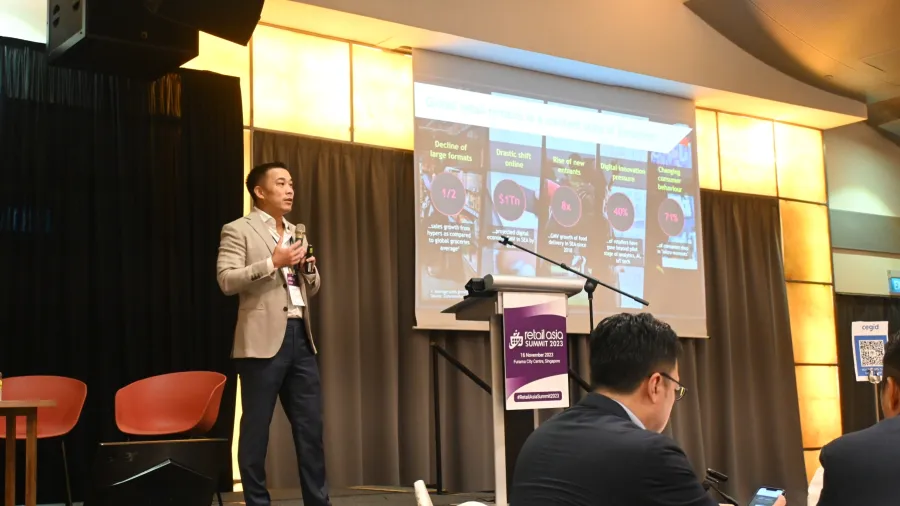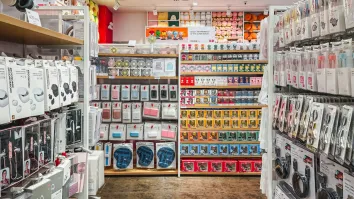
7 trends that shape the retail industry
Brands continue to set their footprint across channels, and are adopting AI and sustainability, amongst others, in their operations.
Omnichannel remains king for retail brands as this provides a convenient and seamless experience for consumers, retail experts shared at the Retail Asia Summit. Alongside the transformation, brands should take into account other trends and practices in the sector including digitalisation, shoppertainment, sustainability, adoption of artificial intelligence (AI), the rise of small format stores, and luxury growth, as these will be crucial in their operations.
Jason Moy, Managing Director and Partner, Boston Consulting Group that retailers need to adopt omnichannel operations which they can pursue through various approaches.
The first approach they can take is through online-to-offline integration. Another approach is through Shoppertainment or content-driven commerce that aims to entertain and educate consumers about certain products. Another approach they can pursue is through personalisation or by leveraging data to provide the customers the “right experience to the right customer at the right time.”
“Omni becomes a huge must for a lot of retailers,” he said. “[T]he shopping journey is no longer driven by physical. The idea that people will go to a store to learn about the product before they buy is no longer relevant. People look online.”
Moy cited Freshippo “New Retail” which integrates online, offline, logistics, and data in a single value chain. This resulted in around two times higher spending per customer compared to pure players, and 30% lower operation cost due to tech-enabled enhancements such as remote store and warehouse inspection, amongst others.
Marco Lim, Commercial Director APAC, Cegid, said brands should turn their points of sale into a “mobile point of service.” He added that a seamless omnichannel experience means “meeting the customers where they are.”
This move requires brands to provide their staff with mobile solutions, providing them with customer data and inventory stock in real time.
For secondhand marketplaces like Carousell, JJ Eastwood, SVP of Brand Solutions at Carousell Group, said consumers still expect the best customer experience. Through the platform, users can sell their products directly to Carousell and they certify the products’ authenticity whilst also providing a warranty.
“There’s a buy button rather than a chat and there’s a transparency around the [products’ authenticity],” he said.
Embracing digital
Hoong An Wong, Regional Director for Partnerships, VIPSHOP Southeast Asia, said that in Singapore, e-commerce sales only account for a small percentage of the total retail sales because it is easy to go to physical stores. With convenience becoming a factor in shopping, Wong said they want to provide a service right to the customer’s doorstep.
Aside from providing personalisation, VIPSHOP is working towards customisation online where they will develop a technology that maps what a person will look like. If the customer is not satisfied with a product, they will allow for returns where they pick up the products on the doorstep.
Consumer behaviour is also influenced by the increased digitalisation. For example in product discovery, Akshay Halve, APAC Senior Regional Brand Manager - Digital Commerce, Colgate-Palmolive, consumers are now informed through live commerce, influencers, on a retail platform itself, and not necessarily through a wider search.
Reviews also matter for consumers, Halve said. Consumers would rather buy from a product with a four-star rating but with around 2,000 reviews, than a product with five-star ratings but only has 25 reviews.
In terms of value, customers also do not necessarily buy a high-priced product or category. They also buy those that have low ticket sizes as they want to know more about the benefits of a product and the technology behind it.
For young e-commerce companies, Christian Kwok, CEO and Co-Founder, of I'VRE, said they want to be able to connect with customers “naturally” through their various social media channels.
As customers want personalisation, Kwok said I’VRE strives to be “as authentic as possible” by showing behind the scenes of the employees.
“We try to give consumers a better idea of who they are dealing with,” he said.
Kwok added that they came up with pop-up stores to deliver experiential shopping to customers who are also seeking contact points.
Spencer Wong, Director Of Business Development, at The Editor's Market, said that for a company with physical stores accounting for 95% of the transactions before, the pivot to digital transformation started around 2016 and 2017.
Wong said that data is a “goldmine” for retailers as this will deliver insights that will help improve the operations which include manufacturing and optimisation.
In a fireside chat, GOC Retail CEO Gavin Fielding also said that retailers should invest in data as this will benefit the business across its entire value chain. This will be crucial for the customer and employee experience as well as data inventory and organisation.
Retailers should also have a roadmap that will help them manage and control the data that they have.
“You can have the most fabulous transformation strategy and journey and plan for technology in your business, but if you get the integration capabilities wrong–that piece of kit that sits in the middle of the universe and enables that amazing sort of flight of data between systems so that you can use it–you're wasting your money,” Fielding said.
The Age of Content
Shopping has evolved to the Age of Content in the mobile-first world, a space dominated by the social media platform TikTok, said Matty Lin, General Manage Global Business Solutions SEA, TikTok.
TikTok, which has 325 million users and 15 million businesses on the platform from Southeast Asia, provides a platform for marketers as it allows content, personalised recommendation, algorithm, and content creator, providing a place online for shoppertainment or the “entertaining content that educates and influences purchases.”
“We are living in the Age of Content. It's critical for us brands to seize the moment to capitalise on the biggest trend in our industry to start building connections with their consumers,” Lin said.
Lin added that online shopping satisfies emotional needs as it provides recommendations, inspirations, and spoils the users.
Shoppertainment addresses these through its key attributes such as emotional and educational storytelling, video-first, authenticity, not forcing decisions, and trends and recommendations.
By leveraging shoppertainment on TikTok, business Prism+ has recorded over $2m in gross merchandise value (GMV) on TikTok Shop in the fourth quarter of 2022.
Melissa Shoes, meanwhile, saw five times GMV uplift on TikTok.
“TikTok presents the biggest opportunity and also how brands can leverage powerful and relevant content that entertains, that help drive and build trust between brands and consumers, and also ultimately drive business results,” Lin said.
AI gains foothold
As digitalisation increases, the rise of artificial intelligence (AI) is proven beneficial for retailers, Moy said. Typically adopted through chatbots and generative AI, he said that this technology allows “a wide range of creation and automation” by generating compelling text, realistic images and video, and taking direct action.
In the future, Moy said there will be more use cases of GenAI such as customer/market expert, store support, reinventing the customer experience, planner, marketer, and programme developer.
Connie Kwok, Expert Partner at Bain & Company, said in a separate panel, that AI is seeing a “real inflection point” where its development is accelerating, adding that there has been a “huge democratisation” of AI, particularly with the introduction of GenAI.
Aside from generating text, GenAI can translate languages and also create video and multimedia content, Kwok said. As such, it can help brands improve cost, enhance productivity, and make products more compelling and competitive.
In a survey conducted with Bain clients, Zhu Hui, Associate Partner at Bain & Company, said they found that enterprises are experimenting with AI. For example, Coca-Cola uses technology to create content including visuals and personalised messaging.
“Traditionally, it has been really difficult to create high-resolution and high-quality visuals. Because you're limited by your marketing budget, you often have to go to your creative agency for these pictures,” Zhu said.
“Now, with AI and generative AI, you can do it almost instantaneously. The value of generative AI can truly be unlocked if you can combine this with traditional customer analytics,” she added.
However, Moy noted the majority of companies globally have yet to unlock the value of AI with 61% observing no impact for three years, 18% seeing effects in revenue, 14% in cost, and 7% seeing unclear impact, citing a global survey by Sloan Management Review.
“Whilst AI is the future of reality, it's not that effective thus far, for many retailers. The reasons are myriad. We don't have good data, we don't trust a black box, and the process doesn't work,” he said.
To unlock the value of AI, Moy said 10% will come from the algorithms, 20% will be from the technology or data platforms and visualisation tools, and 70% will be from processes, people and culture or the data quality and availability, new working and business processes.
“We will need to get to a place where we trust what the computer generates. It is something we're willing to listen to. We will need to change the way we market so that our timelines on how we think about marketing aren't driven by our traditional three-week calendar, but much more real-time,” Moy said.
“All of those processes and changes are really how we're going to unlock the value of AI,” he added.
Small format stores
Whilst omnichannel continues growth, In Southeast Asia, small format stores are also “winning,” capturing around $40b market. Consumers are going to such stores due to their convenient and accessible locations, they offer limited assortment yet competitive prices, and they can pair well with what can be purchased from wet markets.
“If you think about places like Indonesia or Bangkok, the distances are large, and the traffic is bad. And so convenience is an interesting, increasingly important driver for consumption,” Moy said.
With the growth of small format stores, bigger players should rethink their business model. Moy said they should shift their priority from driving store scale through opening new stores to focusing on customer density.
Retailers should identify new customer occasions, serve them through their network of assets and partners and lower the cost on the local operating scale.
“Ultimately, the key behind all of this is data density or the ability to capture more and more information about your consumers, not just when they come through your stores, but when they work [and[ when they come to your partners or other retailers,” he added.
Sustainability
With customers prioritising their contribution to the environment, sustainability becomes part of the core strategies of retailers. For DFI Retail Group, the company has committed to reducing its Scope 1 or direct emissions and Scope 2 or indirect emissions related to purchased energy by 50% by 2030
DFI Retail Group CEO Scott Price said for the Scope 1 and 2 emissions, the company is reducing its footprint through various initiatives such as using LED lights, and water cooling.
For its Scope 3 or the indirect emissions outside a company’s control such as suppliers, the company aims to cut its emissions by 30% by 2030, he added.
In a separate panel, Achint Setia, Chief Revenue and Marketing Officer, ZALORA, said the company aims to be carbon neutral and has been able to reduce its carbon footprint by a third, noting that the fashion industry is a significant contributor to greenhouse gas emissions.
ZALORA’s initiative is anchored on three pillars, first is fair and ethical sourcing, second is the reduction of greenhouse gas emissions, and lastly, circular fashion.
Camille Barthe, General Manager and Head of Marketing, Maison 21G, said that for startup companies like them, it is easier to balance profitability and sustainability as they started with sustainability already in mind across the supply chain.
Luxury growth
Asia also remains the “bright spot” in the personal luxury sector, with the region accounting for 45% of the global personal luxury goods market which reached $325b in 2022, according to PwC data.
Broken down, China accounted for 22% of the total market, Japan for 9%, and the Rest of Asia for 14%. Europe holds a 27% share, the US 24%, and the Rest of the World contributed to the remaining 4%.
“To some extent, we still live in aspirational economies where…buying a big brand that already exists gives you a certain cache, gives you immediate access to a certain lifestyle or to be perceived a certain way. This still holds true to this part of the world where lots of people are coming into the middle class,” said Rakesh Mani, Partner, PwC Strategy&.
One of the shifts in the sector is the consumers’ preference for “insurgent brands” due to their strong online presence and as they cater to the “aspirational young” customers.
As consumer behaviour and demographics evolve, brands have to rethink their offerings to capture the generational divide and ensure customer loyalty.
Ranveer Shrivastav, Director, PwC Strategy& noted that one of the nuances in the loyalty programme amongst luxury brands is that customers who sign up become part of their programme and do not know what they are getting, offering them a surprise.
Brands also need to ensure sustainability in their practices as 70% of the consumers care about the ethical practices of the brands they purchase from.



















 Advertise
Advertise








